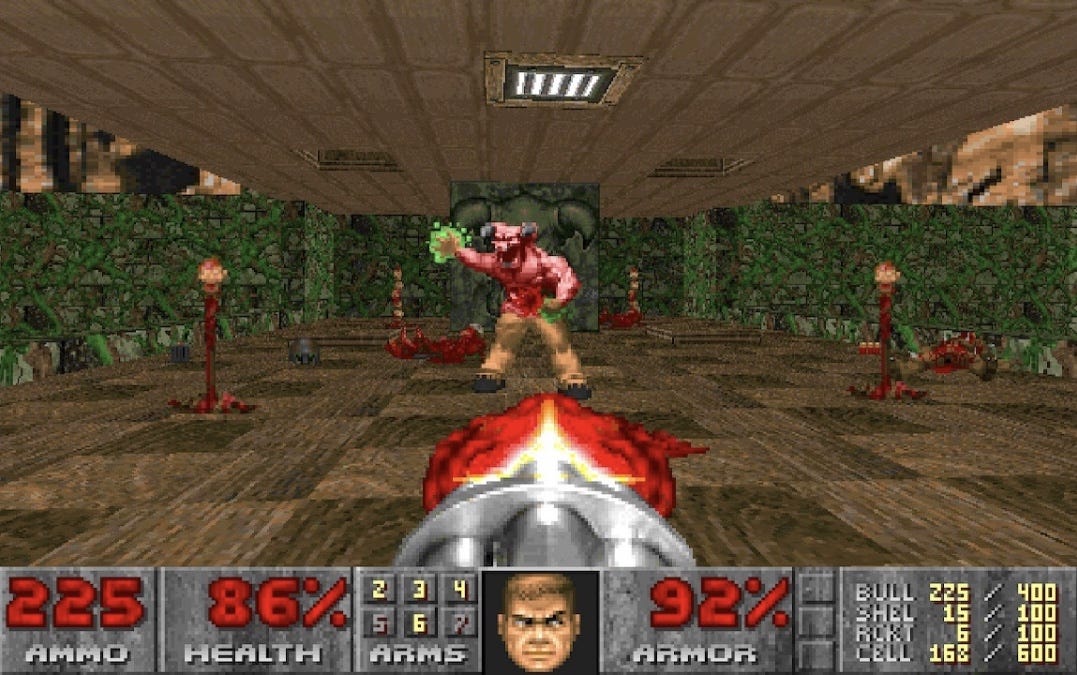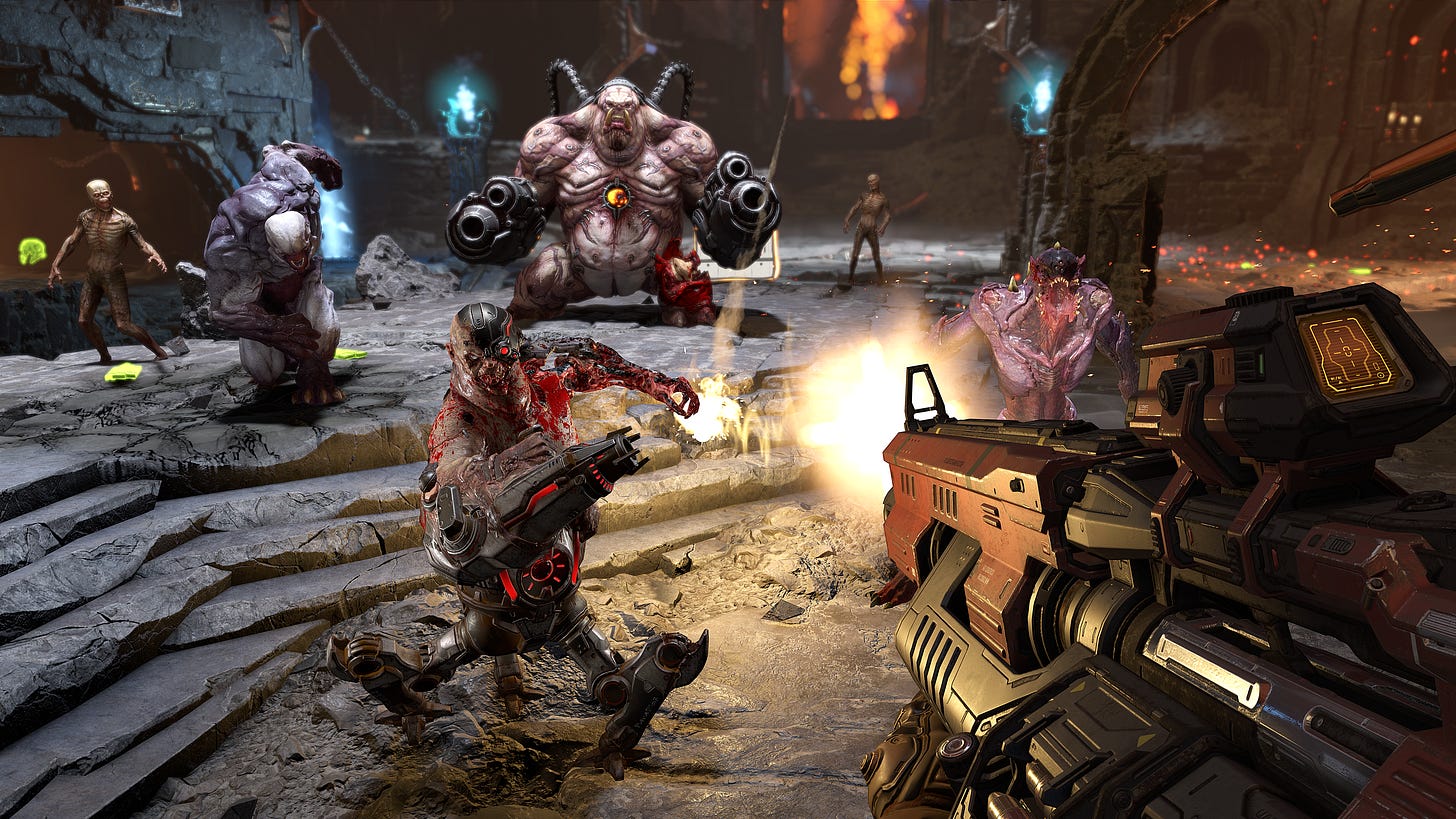Controlling Chaos
The Psychology of Flow and Mastery in DOOM’s Chaotic Gameplay 🔥

There’s a strange kind of calm that comes with ripping through hordes of demons at 200 BPM. It shouldn’t feel peaceful, but somehow, it clicks. Our brains tune into the rhythm of destruction, and we enter a state where time bends, reactions sharpen, and decisions feel instant—it’s glorious.
I found myself thinking about that again recently while reading Masters of DOOM. It got me wondering why this game feels so damn good to play.
Part of that appeal might come from something deeper than design. DOOM taps into our primal instincts. It gives us fear, threat, and the tools to overcome both. It’s a power fantasy wrapped in survival logic, delivering a kind of controlled chaos that somehow feels... therapeutic.
This isn’t just adrenaline—it’s flow. And DOOM might be one of gaming’s purest expressions of it. So, shall we break that down and pull out some UX insight?
🎯 Flow State
Psychologist Mihaly Csikszentmihalyi described flow as a state of full immersion—where challenge and skill are in perfect sync, and everything else fades. Gamers know this well: it’s the moment you forget you’re holding a controller and you’re really “in the zone.”
From a UX perspective, flow isn’t accidental—it’s built. DOOM nails it by aligning player intention with system response. Controls are sharp. Goals are clear. Feedback is immediate. And the difficulty? Just challenging enough to keep you fully engaged, it’s always pushing, but rarely overwhelming.
From the pixelated corridors of the original DOOM to the brutal arenas of DOOM Eternal, the series leans into classic flow triggers: fast loops, rising stakes, and intuitive readability.

You start by running and gunning. Then you learn to move smarter. Manage resources. Chain attacks. Before long, you’re not just surviving—you’re dancing through hell.
DOOM doesn’t eliminate friction—it shapes it. Each small win reinforces the next. It’s a reminder that friction, when intentionally and meaningfully placed, can enhance the experience instead of getting in the way.
To stay in that rewarding state of flow, players need more than just reflexes—they need understanding. And that’s where mastery comes in.
🧠 Mastery Through Repetition and Pattern Recognition
DOOM isn’t just about chaos—it’s about learning. You start clumsy. You miss shots. You die. But a few arenas later, you’re gliding through it all with confidence. That’s not luck. That’s mastery.
Every demon has a role. Every weapon, a purpose. Each encounter is a fast, brutal puzzle. You scan the space, prioritize threats, and solve through movement.

Game Maker’s Toolkit breaks this down beautifully with the 4 P’s of DOOM’s combat:
Push-forward combat – You gain health by charging forward, not hiding. Aggression is the safest strategy.
Power resource management – Glory kills, chainsaws, and flamethrowers all feed your resources. Knowing when and how to use them is key to survival.
Positioning – Every arena is spatial. You’re thinking in movement: where to dash, jump, or flank.
Pace – DOOM knows when to ease off. A quiet corridor here, a light puzzle there—just enough to reset before the next onslaught.
The brilliance is in how the game teaches without telling. You’re constantly improving, guided by tension and timing. And when it clicks, sequences like “glory kill into double jump into mid-air snipe” don’t feel like effort—they feel like instinct. They feel like flow.
🧩 Final Notes
From a UX point of view, DOOM plays with friction in a way that teaches rather than punishes. Encounters are rarely easy—but never unfair. Funny how a game this wild can teach us about control, and how pacing supports mastery in this case.
Most importantly, this game trusts the player. It skips hand-holding tutorials and throws you into hell with a simple message: “Figure it out.” That trust makes each breakthrough feel earned. You don’t just finish the game—you prove yourself worthy of it, one blast at a time.
With DOOM: The Dark Ages coming up, the question is: how will the franchise evolve?
Will the medieval setting disrupt the rhythm, or take it somewhere new?
Will it refine what works, or throw us into a fresh kind of chaos?
We’ll find out soon enough. 😈
Wanna Learn More?
Here are some fantastic resources for you:

